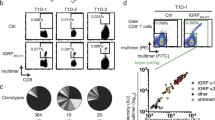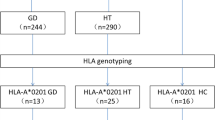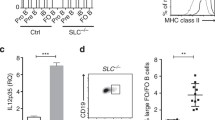Abstract
We have previously reported that the 17mer thyroglobulin (Tg) peptide TgP1 (a.a. 2495–2511) induces experimental autoimmune thyroiditis (EAT) inH-2 k mice, a process requiring expression ofE k genes, and inH-2 S mice that lack functional E molecules. To test whether this apparent discrepancy was due to recognition of distinct TgP1 determinants in each strain, we mapped in this study minimal T -cell epitopes within TgP1 and examined their pathogenicity in C3H (H-2 k) or SJL (H-2 S) mice. Truncation analysis using TgP1-specific, CD4+ hybridomas from C3H mice identified two overlapping determinants, (2496-2504) and (2499–2507), that were restricted by the Ek and Ak molecules, respectively. Subsequent challenge of C3H and SJL mice with these 9mer peptides revealed that the Ekrestricted (2496–2504) determinant elicited EAT and specific proliferative LNC responses in both strains, suggesting recognition in the context of As, since this is the only class II molecule expressed in SJL mice. This was further confirmed by blocking of the proliferative LNC response by an As-specific monoclonal antibody. In contrast, the Ak-restricted (2499–2507) determinant induced weak EAT and no proliferative LNC responses in either strain. These data 1) delineate the 9mer (2496–2504) peptide as a minimal Tg T-cell epitope with direct pathogenic potential in mice and 2) highlight the use of nonisotypic MHC class II molecules for the presentation of this peptide in mice of differentH-2 haplotypes.
Similar content being viewed by others
References
Allannic, H., Fauchet, R., Lorcy, Y., Heim, J., Gueguen, M., Leguerrier, A., and Genetet, B. HLA and Graves' disease: an association withHLA-DRw3.J Clin Endocrinol Metab 51: 863–867, 1980
Allen, P. M., McKean, D. J., Beck, B. N., Sheffield, J., and Glimcher, L. H. Direct evidence that a class 11 molecule and a simple globular protein generate multiple determinants.J. Exp Med 162: 1264–1274, 1985
Balasa, B. and Carayanniotis, G. Induction of experimental autoimmune thyroiditis in rats with the synthetic peptide (2495-2511) of thyroglobulin.Cell Immunol 148: 259–268, 1993
Carayanniotis, G., Chronopoulou, E., and Rao, V. P. distinct genetic pattern of mouse susceptibility to thyroiditis induced by a novel thyroglobulin peptide.Immunogenetics 39: 21–28, 1994
Champion, B. R., Page, K. R., Parish, N., Rayner, D. C., Dawe, K., Biswas-Hughes, G., Cooke, A., Geysen, M., and Roitt, I. M. Identification of a thyroxine containing self epitope of thyroglobulin which triggers thyroid autoreactive T cells.J Exp Med 174: 363–370, 1991
Chicz, R. M., Urban, R. G., Gorga, J. C., Vignali, D. A. A., Lane, W. S., and Strominger, J. L. Specificity and promiscuity among naturally processed peptides bound to HLA-DR alleles.J Exp Med 178: 27–47, 1993
Chronopoulou, E., and Carayanniotis, G. Identification of a thyroiditogenic sequence within the thyroglobulin molecule.J Immunol 149: 1039–1044, 1992
Chronopoulou, E. and Carayanniotis, G. H-2Ek expression influences thyroiditis induction by the thyroglobulin peptide (2495–2511).Immunogenetics 38: 150–153, 1993
Dayan, C. M., Londei, M., Corcoran, A. E., Grubeck-Loebenstein, B., James, R. F. L., Rapoport, B., and Feldmann, M. Autoantigen recognition by thyroid infiltrating T cells in Graves disease.Proc Natl Acad Sci USA 88: 7415–7419, 1991
Engelhard, V. H. Structure of peptides associated with class I and class II MHC molecules.Annu Rev Immunol 12: 181–207, 1994
Falk, K., Rötzschke, O., Stevanović S., Jung, G., and Rammensee, H-G. Pool sequencing of natural HLA-DR, DQ and DP ligands reveals detailed peptide motifs, constraints of processing, and general rules.Immunogenetics 39: 230–242, 1994
Farid, N. R., Sampson, L., Noel, E. P., Barnard, J. M., Mandeville, R., Larsen, B., Marshall, W. H., and Carter, N. D. A study of human leukocyte D locus related antigens in Graves' disease.J Clin Invest 63: 108–113, 1979
Gillis, S. and Smith, K. A. Long term culture of tumor-specific cytotoxic T cells.Nature 268: 154–156, 1977
Gregerson, D. S., Fling, S. P, Obritsch, W. F., Merryman, C. F., and Donoso, L. A. Identification of T cell recognition sites in S-antigen: Dissociation of proliferative and pathogenic sites.Cell Immunol 123: 427–440, 1989
Hill, C. M., Hayball, J. D., Allison, A. A., and Rothbard, J. B. Conformational and structural characteristics of peptides binding to HLA-DR molecules.J Immunol 147: 189–197, 1991
Hunter, S. Experimental allergic encephalomyelitis: clinical disease and enhanced cellular transfer in the absence of lymphocyte proliferative responses against syngeneic MBP.Cell Immunol 97: 204–209, 1986
Hutchings, P. R., Cooke, A., Dawe, K., Champion, B. R., Geysen, M., Valerio, R., and Roitt, I. M. A thyroxine-containing peptide can induce murine experimental autoimmune thyroiditis.J Exp Med 175: 869-872
Leighton, J., Sette, A., Sidney, J., Appela, E., Ehrhardt, C., Fuchs, S., and Adorini, L. Comparison of structural requirements for interaction of the same peptide with I-Ek and I-Ed molecules in the activation of MHC class II-restricted T cells.J Immunol 147: 198–204, 1991
Malthiery, Y and Lissitzky, S. Primary structure of human thyroglobulin deduced from the sequence of its 8448-base complementary DNA.Eur J Biochem 165: 491–498, 1987
Nanda, N. K., Arzoo, K. K., and Sercarz, E. E. In a small multideterminant peptide each determinant is recognized by a different Vß gene segment.J Exp Med 176: 297–302, 1992
Nepom, G. T., and Concannon, P. Molecular genetics of autoimmunity. In N. R. Rose and I. R. Mackay (eds.):The Autoimmune Diseases II, pp. 127–152, Academic Press, Toronto, 1992
Oi, V T., Jones, P. P, Goding, J. W., and Herzenberg, L. A. Properties of monoclonal antibodies to mouse Ig allotypes, H-2 and la antigens.Carr Top Microbiol Immunol 81: 115–129, 1978
Ozato, K., Mayer, N., and Sachs, D. H. Hybridona cell lines secreting monoclonal antibodies to mouse H-2 and la antigens.J Immunol 124: 533–540, 1980
Perkins, D. L., Beriz, G., Kamradt, T., Smith, J. A., and Gefter, M. L. Immunodominance: intramolecular competition between T cell epitopes.J Immunol 146: 2137–2144, 1991
Rothbard, J. B. and Taylor, W. R. A A sequence pattern common to T cell epitopes.EMBO J 7: 93–100, 1988
Rudensky, A. Y, Preston-Hurlburt, P., Al-Ramadi, B. K., Rothbard, J., and Janeway, C. A., Jr. Truncation variants of peptides isolated from MHC class II molecules suggest sequence motifs.Nature 359: 429–431, 1992
Scharf, S. J., Freidmann, A., Steinman, L., Brautbar, C. and Erlich, H. A. Specific HLA-DQB and HLA-DRBI alleles confer susceptibility to pemphigus vulgaris.Proc Natl Acad Sci USA 86: 6215–6219, 1989
Stewart, C. C. Cell preparation for the identification of leukocytes.In Z. Darzynkiewicz and H. Acrissman (eds.):Flow Cytometry. Methods in Cell Biology (vol 33), pp. 411–426, Academic Press, New York, 1990
Vacchio, M. S., Berzofsky, J. A., Krzych, U., Smith, J. A., Hodes, R. J., and Finnegan, A. Sequences outside a minimal immunodominant site exert negative effects on recognition by staphylococcal nuclease-specific T cell clones.J Immunol 143: 2814–2819, 1989
Weetman, A. P. Autoimmune thyroiditis: predisposition and pathogenesis.Clin Endocrinol Oxf. 36: 307–323, 1992
White, J., Blackman, M., Bill, J., Kappler, J., Marrack, P., Gold, D. P., and Born, W. Two better cell lines for making hybridomas expressing specific T cell receptors.J Immunol 143: 1822–1825, 1989
Yewdell, J. W., Frank, E., and Gerhard, W. Expression of influenza A virus internal antigens on the surface of infected P815 cells.J Immunol 126: 1814–1819, 1981
Author information
Authors and Affiliations
Rights and permissions
About this article
Cite this article
Rao, V.P., Balasa, B. & Carayanniotis, G. Mapping of thyroglobulin epitopes: Presentation of a 9mer pathogenic peptide by different mouse MHC class II isotypes. Immunogenetics 40, 352–359 (1994). https://doi.org/10.1007/BF01246676
Received:
Revised:
Issue Date:
DOI: https://doi.org/10.1007/BF01246676




